
Hats off to diversity: Exploring headwear from around the world
What's the story
Hats have been an integral part of human history for centuries, serving not only as practical accessories for protection but also as symbolic markers of culture, identity, and tradition. These traditional headpieces from around the world tell stories of their wearers' heritage, social status, and beliefs. Here is a list of five such traditional hats that are iconic to various cultures.
Hat 1
Fez from the Middle East
The word "fez" comes from the Moroccan city of Fez, where red berries were used to make the dye for the hat. Fez is frequently associated with men's clothing from Morocco and the Middle East. Variations of the fez can be seen from Cyprus to Serbia. The brimless, flat-topped felt cap gained popularity during the Ottoman Empire.
Hat 2
Aussie bush hat
The Aussie bush hat was first used in 1885 and has been a part of the Australian Army uniform since 1903. The broad-brimmed Aussie bush hat has a comfortable wide brim and is constructed of weatherproof rabbit fur felt. Since then, it has been worn by heads of state, members of the royal family, celebrities, and the general populace.
Hat 3
Sombrero from Spain
This hat, which was created to shield the user from the hot, Iberian climate, was swiftly copied by other Spanish-speaking nations like Mexico and several Latin American nations. This particular hat has been historically associated with social standing and is believed to have originated with the Mestizo cowboys of Central Mexico. Wealth was denoted by wider brims, ornamental features, and more expensive materials
Hat 4
Conical Asian hat
These conical hats are popular in several nations between East and South Asia. It's a useful hat usually made of straw or other woven materials to protect wearers from the sun and rain, making it a great option for farmers from Vietnam to Japan. In the past, aristocrats also wore these conical hats that were embellished with jewels or other decorations.
Hat 5
Bowler hat in England
Bowler hat, a symbol long associated with the city of London, was a main component of every city worker's uniform. Cowboys, lawmen, and railroad employees all donned them because of their snug fit and narrow brim, which kept them from flying away while on horseback. Interestingly, bowler hats have also developed into a significant piece of Bolivian women's traditional attire since the 1920s.